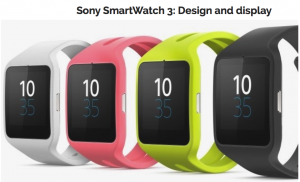In the post CES world of wearable devices, attention is once again shifting to Apple and its looming launch of the long-discussed Apple Watch wearable device.

Look for this no later than March 2015 (so we are weeks away) with all the tell-tale signs that include hints of Retail training programs in process, new Beta versions of iOS8 (v.8.2) include Bluetooth pairing instructions specifically for the Apple Watch, not to mention the appearance of the Apple Watch Emulator appearing online to assist software developers with new Apps for the device. And much like the pre-iPod, iPhone and iPad era that preceded the launch of Apple’s ground-breaking litany of hit products, the wearable market is already alive with plenty of wearable devices selling in the market. There aretop sellers like FitBit, a single sensor stand-alone device for fitness tracking, and multi sensor smartwatches backed by the Android OS of one vintage or another talking to your smartphone.
But more than this, in the recent CNET buyers guide review published last month, the group sums up this muddled market quite succinctly by stating “(Hint: it’s a messy, muddy place)” calling it a “swamp” and “…a hot mess of competitive products”, when referring to the smartwatch and fitness tracker marketplace of late 2014, in its pre-CES write-up.
Now add to this, a new crop of smartwatches introduced at CES sporting both display and non-display wearables from tier-one CE makers. This includes LG’s G Watch R and new Web OS versions shown at the Audi Booth unlocking the car door using the wearable device. Also Samsung‘s Gear S watch recently shown with a new Swarovski crystal strap (to give it an upgraded look) and the company is also reported to be working on a new “round version” (shown with mock-up sketch) that will debut at the upcoming Mobile World Congress in Barcelona, Spain.
Count ’em up, Tier one brands alone at CES included
- Lenovo, and it’s newly acquired Moto group with a new Gold Moto 360 smartwatch that appeared on a recent Amazon site before being taken down;
- Epson America with a new line of Epson Active wearables, and attachable (to a golf club shaft) devices targeting sport health and fitness categories;
- Asus Zen watch with features not unlike the current shipping Samsung offering that includes voice commands and SIM-card slot; and the
- Sony SmartWatch3 that includes GPS tracking, shown in the US at CES, but introduced at IFA last Fall.
 It’s almost as if Apple waits for this kind of “ripe for the picking” season, bringing its new product category device into a market, flooded with alternatives, varying degrees of functionality and general disarray over the true value proposition the technology can bring to users. Then with a simple, elegant and outstanding best-in-class product they execute a strategy that looks to rise above the fray, with Apple’s tried and true formula: It’s not about functionality, or a litany of check boxes on a spec sheet, but rather, what technology can bring to the user in an “accessible, relevant and personal way.
It’s almost as if Apple waits for this kind of “ripe for the picking” season, bringing its new product category device into a market, flooded with alternatives, varying degrees of functionality and general disarray over the true value proposition the technology can bring to users. Then with a simple, elegant and outstanding best-in-class product they execute a strategy that looks to rise above the fray, with Apple’s tried and true formula: It’s not about functionality, or a litany of check boxes on a spec sheet, but rather, what technology can bring to the user in an “accessible, relevant and personal way.
The company asserts its software is so tightly integrated with the device (and its new innovations), that there is no clear boundary between the two. It’s created with the stated goal to “…connect with the wearer at an intimate level”, according to VP of Product Design Sir Jonathan Ive, on the Apple Watch web site. He seeks to both “embrace individuality and inspire desire”. Spend five minutes here and, I promise you, it will be hard to resist.
Did Apple succeed with it’s formula in the past? That would be a resounding yes. One look at Market Cap is enough to convince most of that fact. Can it do it again with the Apple Watch? Well that is the question at hand, and the proof of the pudding shall be in the eating. Apple is the master at showing people things they never knew they wanted, or needed, then stepping back and letting the individuality and desire work its magic. This is greatly enhanced by the creativity of tens of thousands of App Developers, now working on Apple Watch apps. So as one looks at the previous mobile device categories the company targets and now dominates at the profitable high-end of each of these markets, it’s a safe bet to say don’t bet against them. – Steve Sechrist

